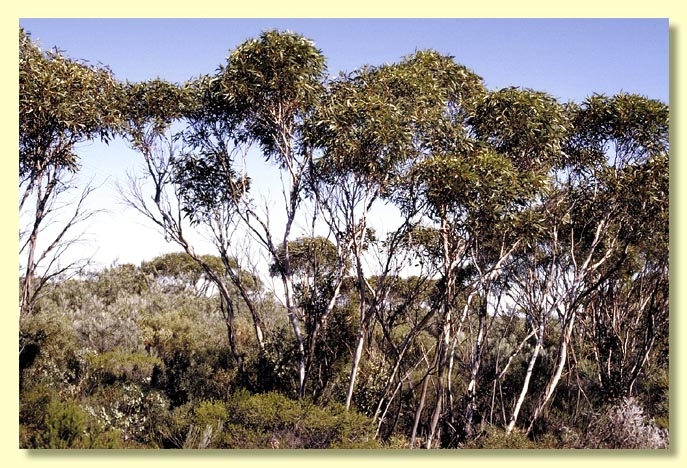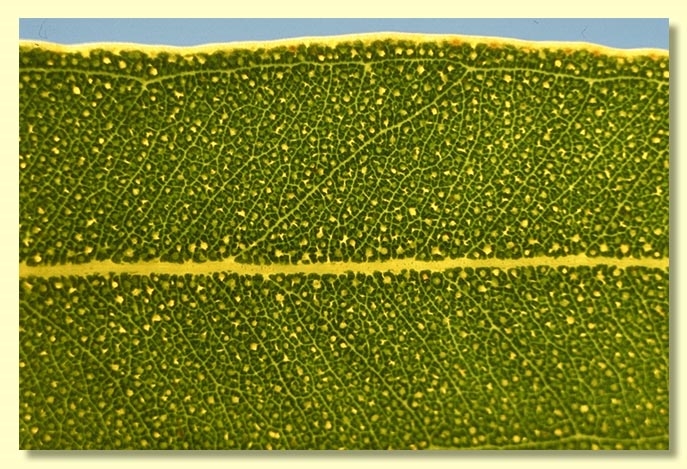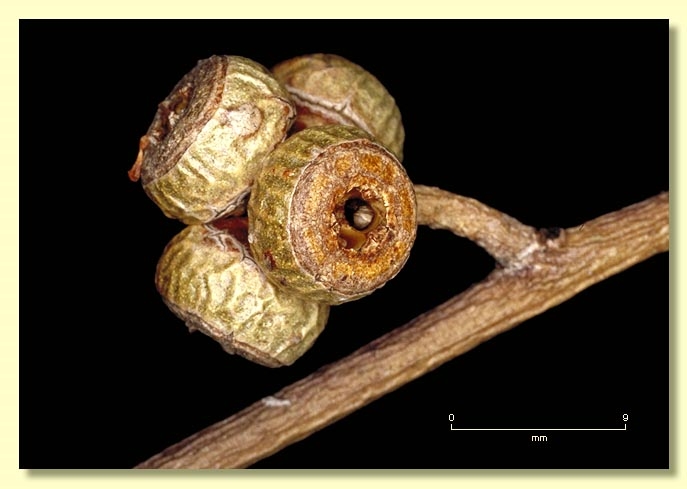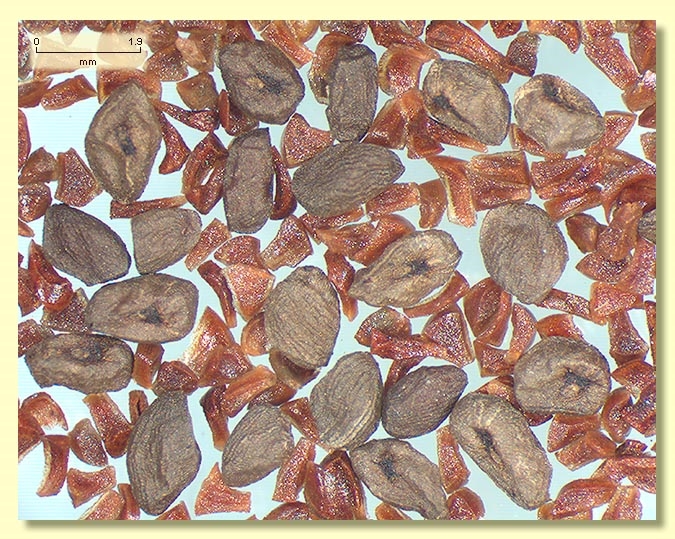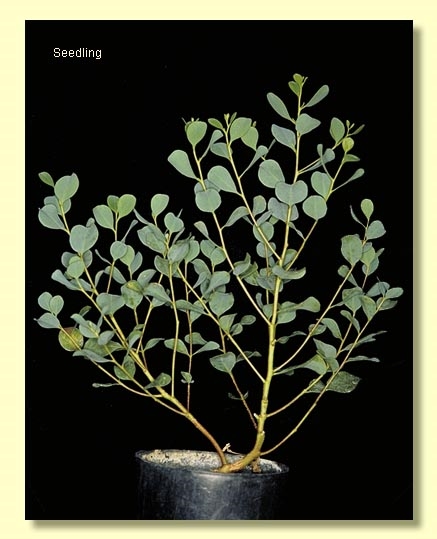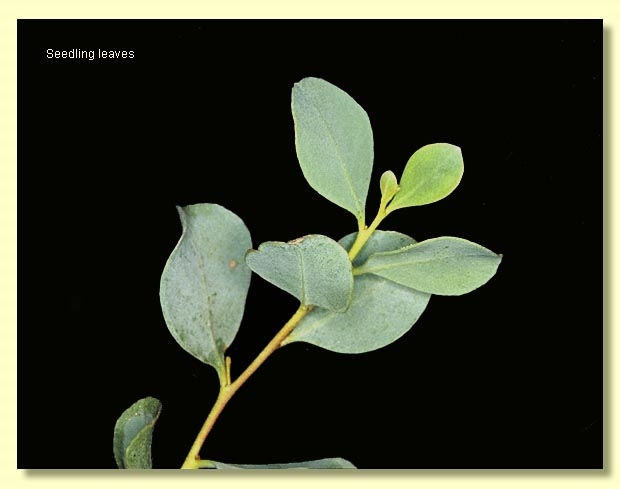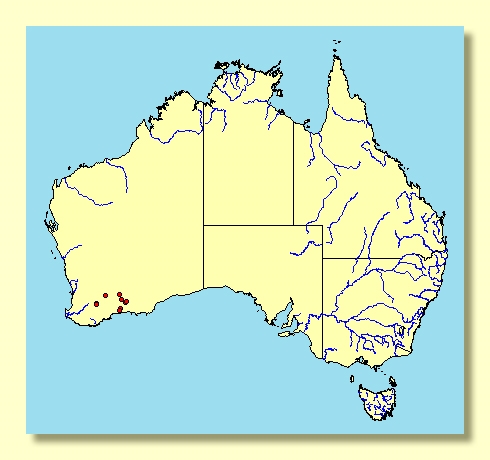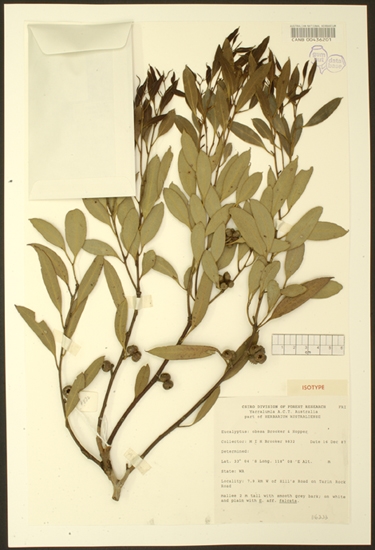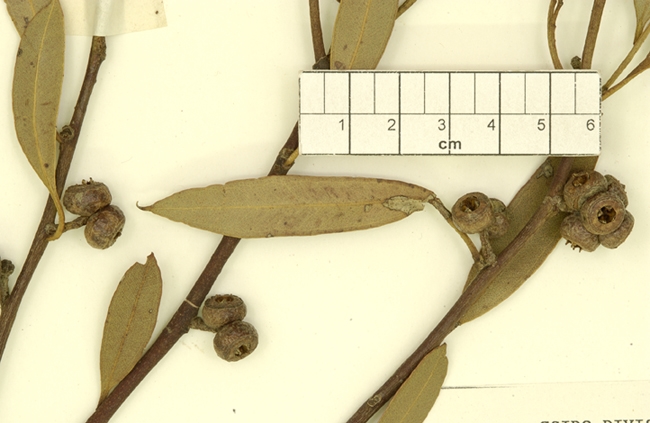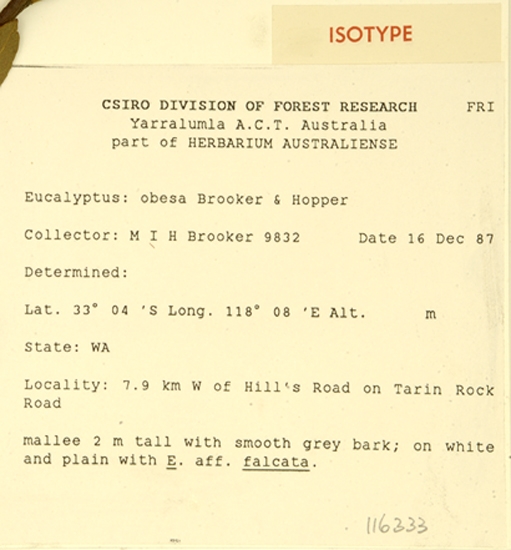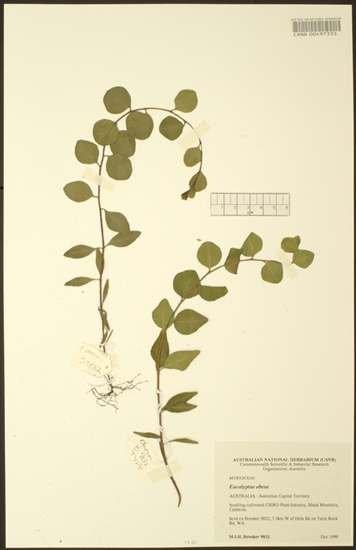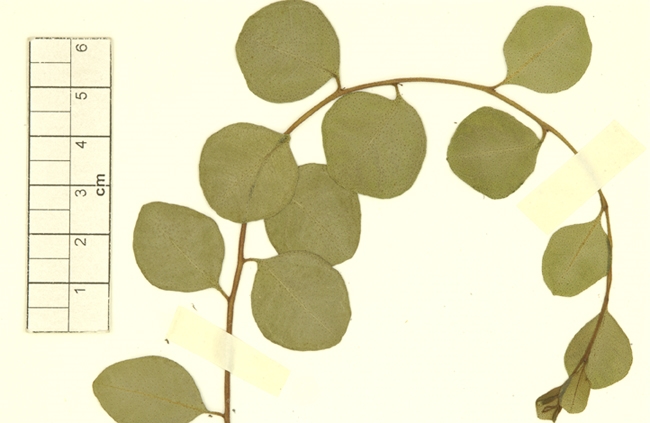Eucalyptus | Symphyomyrtus | Bisectae | Destitutae | Falcatae | Decipientes
Euclid - Online edition
Eucalyptus obesa
Bark smooth throughout shedding in ribbons, grey over whitish to pale brown or pink.
Branchlets lacking oil glands in the pith.
Juvenile growth (coppice or field seedlings to 50 cm): stems rounded in cross-section; juvenile leaves always shortly petiolate, opposite for very few nodes then alternate, lower leaves obcordate or obovate, later becoming elliptical to ovate, 3–5.5 cm long, 1.5–3 cm wide, margin subcrenulate to entire, apex emarginate to rounded or sometimes broadly acute, dull, grey-green.
Adult leaves alternate, petioles 0.7–2.2 cm long; blade usually lanceolate, sometimes almost elliptical, (5)6.5–10.5(11.7) cm long, 0.8–2 cm wide, base tapering to petiole, margin entire, apex pointed, concolorous, glossy, dark green, side-veins at an acute or wider angle to midrib, reticulation dense, intramarginal vein remote from margin, oil glands mostly intersectional.
Inflorescence axillary unbranched, peduncles 0.3–1 cm long (to 2 cm long at Peak Charles); buds ?11 or 13, sessile. Mature buds squatly ovoid (0.6–0.8 cm long, 0.4–0.5 cm wide), scar present, operculum broadly conical, stamens inflexed, anthers small, reniform to ± globoid, versatile, dorsifixed, dehiscing by short oblique slits, style long and straight, stigma blunt to rounded, locules 3 or 4, the placentae each with 4 vertical rows of ovules. Flowers creamy white.
Fruit sessile, crowded, flattened and truncate-globose to hemispherical, 0.4–0.7 cm long, 0.6–1.1 cm wide, disc level, valves 3 or 4, at rim level or slightly exserted.
Seeds dark brown to grey-brown, 1–2.2 mm long, ovoid or flattened-ovoid, dorsal surface smooth, hilum ventral.
Cultivated seedlings (measured at ca node 10): cotyledons Y-shaped (bisected); stems rounded in cross-section, smooth to slightly warty; leaves virtually sessile to shortly petiolate, opposite for 5–8 nodes then becoming alternate, orbicular to obovate or obcordate, 1.5–2.5 cm long, 1–2.5 cm wide, base rounded to tapering, margin subcrenulate or entire, apex rounded to truncate or emarginate, dull, greyish green contrasting with the very green new tip growth.
Flowering has been recorded in January, November and December.
A mallee endemic to Western Australia occurring sporadically in mallee scrub in the southern wheatbelt, e.g. Dongolocking, Tarin Rock area north-west of Lake Grace, 90-mile Tank east of Lake King, and Peak Charles and nearby areas from Salmon Gums to Scadden north-east of Esperance. In subcoastal areas it is found in the Jerdacuttup area and very sporadically east as far as Condingup. It has slender smooth-barked trunks, glossy green leaves and short cylindrical buds in clusters of up to 13.
In the classification of Brooker (2000) Eucalyptus obesa is in Eucalyptus subgenus Symphyomyrtus section Bisectae subsection Destitutae because buds have two opercula, cotyledons are Y-shaped and branchlets lack oil glands in the pith. Within this sub-subsection E. obesa, E. decipiens and E. adesmophloia form a distinctive small group, series Falcatae subseries Decipientes , with shortly stalked or sessile buds in crowded stellate clusters in the leaf axils, crowded fruit and adult leaves having numerous side-veins, dense reticulation and intersectional oil glands. Three other species, E. communalis, E. balanites and E. phylacis were formerly included in subseries Decipientes , but are now regarded as hybrids or intergrades.
E. obesa differs from both E. decipiens and E. adesmophloia in being completely smooth-barked, and having more cylindrical, less spindle-shaped buds, more rounded operculum and wider and flatter fruit (though with some overlap in dimensions).
Plants in the Coolinup Road—Kau Rock area east of Esperance may be referrable to E. obesa but this needs further investigation.
Occasionally plants are found emergent from heathland in Fitzgerald River National Park that are intermediate in form between Eucalyptus obesa and E. adesmophloia. They form distinctive clumps of slender smooth-barked mallees and are not common. They have slightly fatter pointy and more cylindrical buds than does E. adesmophloia and but lack tthe shorter more rounded apiculate operculum of E. obesa. These plants were originally described as Eucalyptus communalis Brooker & Hopper and treated as such in earlier editions of EUCLID but are now considered to be rare intergrades between these two species.
For further discussion of these intergrades see Nicolle & French (2012) through this link:
http://florabase.dpaw.wa.gov.au/science/nuytsia/653.pdf

